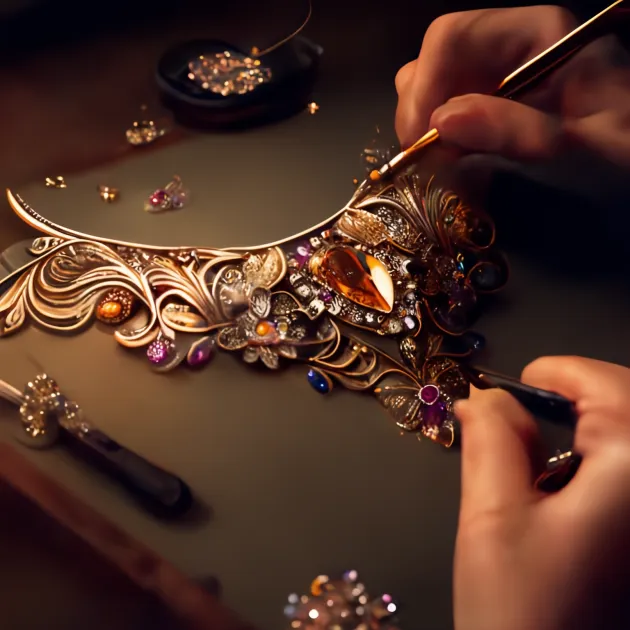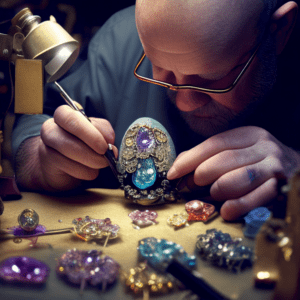Has jewelry always captured your heart? Beautiful jewelry can elevate any attire, symbolize a milestone in your life, or tell a story from generations past. Adding a little sparkle to your life can lift your spirits and make you feel special. The artists behind these precious pieces are called jewelers. Jewelers are fine artists who must be skilled at handcrafting to produce attractive, original designs.
Instead of being a salesperson in a jewelry store, how would you like to be the one who designs it?
If you want to become a professional jeweler, this post will guide you through the process step-by-step. Now that we know the definition of a jeweler, let’s find out what they do.
Responsibilities of a Jeweler
A jeweler must be well-versed in metals, gems, and stones and keep current on the latest trends and assembly methods. Additionally, they must:
- Design models, then mold precious metals and stones as needed to make new and unique jewelry
- Repair jewelry pieces by cutting to reduce sizes, attaching clasps, etc.
- Sculpt stones to fit into jewelry and fix them into place.
- Ensure that jewelry joints are smooth and polished.
- Conduct quality assessments and research on metals, gems, and stones
- Calculate a profit margin by studying business, labor, material, and other costs.
What Types of Equipment Does a Jeweler Need?
A jeweler needs several pieces of equipment, but these may not all be required based on the materials used to make your designs. If working for a business, they will have the tools needed, but you will need to know how to use them.
- Pliers
- Jewellers Anvil
- Jeweler’s saw
- Wire Cutters
- Bench Hammer and Bench Knife
- Loupe
- Burrs and Burr Sets
- Bead Reamers
- Sharpening Stone
- Vernier Calipers & Divider Calipers
- Hand and Needle Files
- Bench Vise
- Hearing protection
- Safety Goggles & Face Shields
- Try Square
- Soldering Torches & Tools
- Flexible Shaft and Shaft Tools
- Engraving Tools
- Drill Bits and Rotative Tools
- Finishing Tools
It is fair to say that artistic talent and creativity are prerequisites to becoming a great jeweler. Unless you possess some innate talent, this profession may prove challenging.
I am going to get down to business and explain how to become a jeweler. In this section, I will examine the training and education required to become a successful tradesperson.
Training and Education Requirements
- Achieve High School Graduation
Obtaining your high school diploma is mandatory as a first step. To learn the basics of design, taking art classes in high school would be beneficial. It is never too early to get those creative juices flowing. Also, a little self-learning never hurts and can be done by reading books and tutorials on jewelry creation.
- Enroll in a Jewelry-Making Program
You may take a jewelry-making program through a vocational or technical institute. The training lasts six months to one year and typically has a flexible schedule. This is great for those who work.
You will learn how to tackle that jewelry equipment, polishing, stone setting, laser welding, enameling, crafting, and repairing jewelry. Most programs teach you CAD (computer-aided design) software. Making 2D or 3D models proves helpful prior to generating the final product.
- Become an Apprentice
Work side-by-side with a professional jeweler. Applying to be an apprentice is possible after high school and while studying in a jewelry-making program. This hands-on experience with a professional in the vocation is invaluable.
- Achieve a Degree From an Accredited Institution
Obtaining an associate’s or bachelor’s degree is unnecessary to become a jewelry designer. However, it will provide additional skill development and make you more employable because you will require less training.
Check out Jewelers of America for information on the top jewelry schools.
Many jewelers in the making select Jewelry Design and Fine Arts as their optimal courses. Jewelers learning Jewelry Design will be better equipped for a professional career; hence this is the more applicable choice between the two. In a Jewelry Design program, you may learn art history, basic design principles, and how to bring your ideas to life.
A Fine Arts degree will introduce you to sculptures, paintings, architecture, music, poetry, etc. You will also learn about artistic creations that appeal to the eye, which is crucial when designing jewelry.
- Portfolio Compilation
This is where you can crown your efforts into a compilation of exquisite jewelry designs. You may showcase it online or in a hard case folder. Use this portfolio to prove your talent to a potential employer. Be sure to use a high-resolution camera when taking photos to present your work in the best light.
- Enter the Job Market by Applying for Entry-Level Positions
You will most likely begin your career with an entry-level position. Bench jewelers typically work for retail shops, manufacturing plants, jewelry showrooms, or repair shops. Taking a sales position may be necessary initially in your career.
- Become a Certified Professional
For advancement purposes, it is best to obtain certifications. Certifications offered by Jewelers of America include the following:
- Certified Bench Jeweler Technician (CBJT)
- Certified Bench Jeweler (CBJ)
- Certified Senior Bench Jeweler (CSBJ)
- Certified Master Bench Jeweler (CSMJ)
Each one of these certificates represents your level of achievement in the jewelry-making business. After about a year, you should receive your Certified Bench Jeweler Technician. Within two years, you will qualify for the Certified Bench Jeweler.
The Certified Senior Bench Jeweler and the Certified Master Bench Jeweler must possess years of experience and require written and several practical tests. This could take a decade or longer as advanced degrees are needed.
- Keep Learning
Continuous learning is essential to advance in your jewelry occupation. For example, receiving a degree in Gemology or antique jewelry will open more doors of opportunity. Also, if you haven’t gotten your associate’s or bachelor’s degree after working in the field, consider doing so to show your talent and commitment.
A Few More Mentions
Becoming a jeweler may take a few months to four years, depending on where you start your education. After high school, you may begin an apprenticeship. If you complete a training program or earn a degree, becoming a Jeweler may take one to four years.
If you are considering operating your own jewelry business, take some business classes such as accounting, marketing, and management along with your jewelry curriculum.
Display your skills at gem and jewelry shows to gain a more profound knowledge of the jewelry industry, consumer tastes, and the competitive market.
Despite a steady decline in jewelers entering the workforce, jewelers still experience higher job satisfaction. In jewelry making, the calm and peaceful work environment and creativity contribute to people’s career satisfaction.
Final Thoughts
Jewelers are involved in a dynamic industry. If you possess artistic skills, fashion sense, entrepreneurial ability, and are friendly, then this career path may be right for you. You can customize your future based on your educational options and personal preferences. Considering the work environment and diversity, you may find this an exciting career choice.



